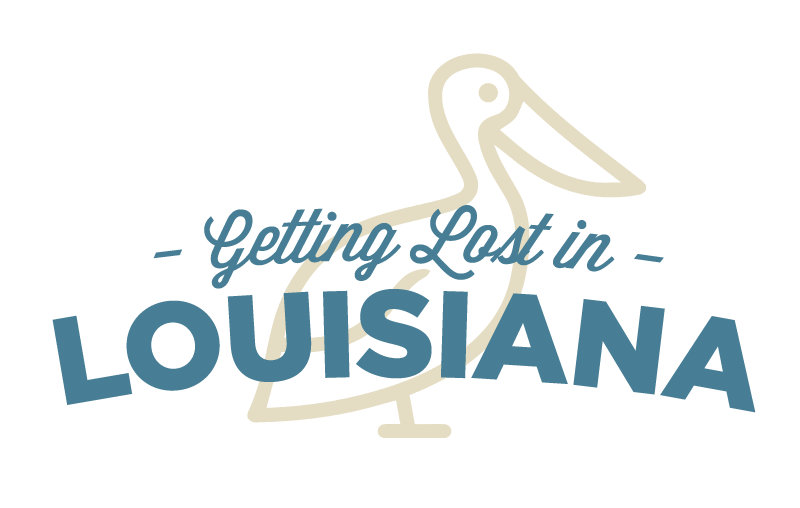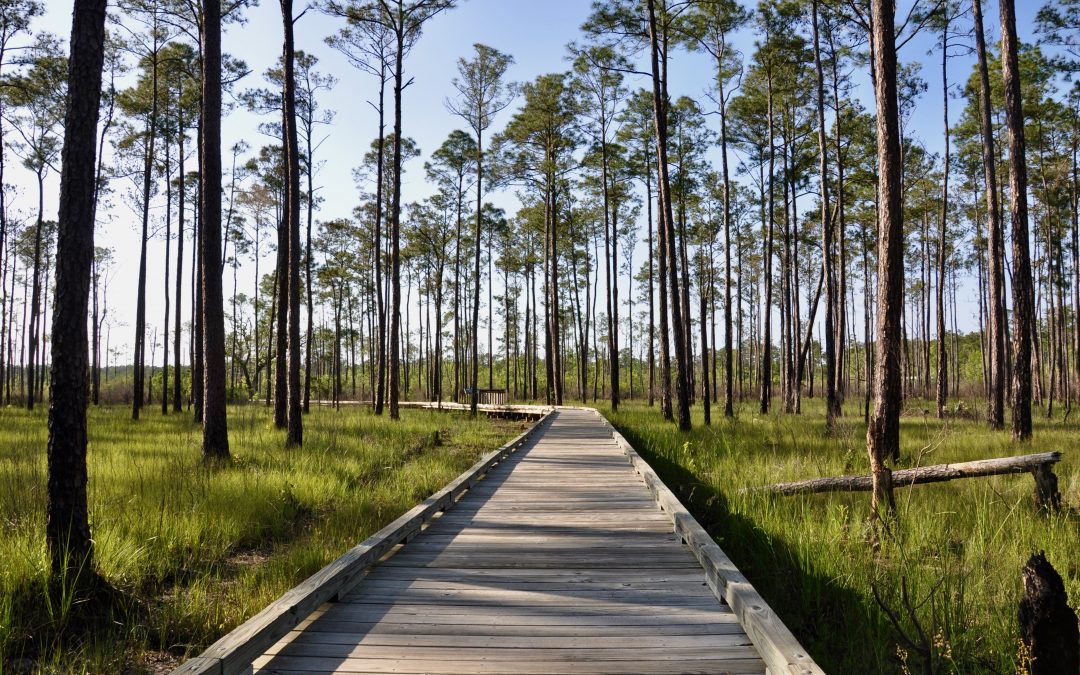
by admin | Sep 25, 2019 | Featured Posts, Greater Baton Rouge, Greater New Orleans, Most popular, North Louisiana
The words hiking and Louisiana don’t often go together. They certainly don’t conjure up images of rugged mountain trails past bubbling creeks. But if you know where to look, Louisiana offers a unique chance to get outdoors in a different way. Discover a boardwalk trail through a cypress swamp, a beautiful waterfall just over the state line or a taste of our “hill country.” Here are some of our favorite day hikes in Louisiana.
Jean Lafitte National Historical Park and Preserve and Wetland Trace
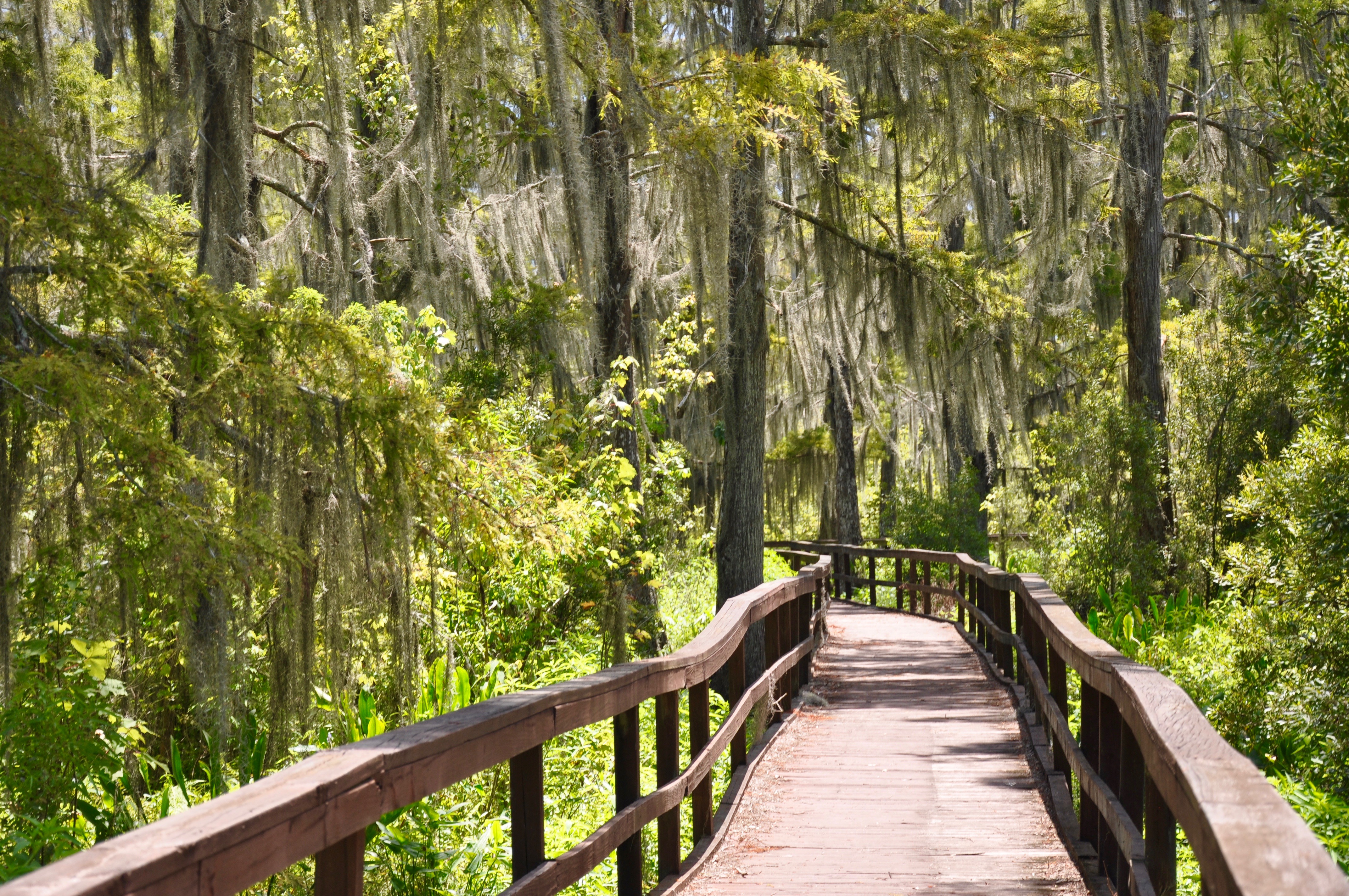
Jean Lafitte (both the park and the town) is about a half hour drive south of New Orleans. At the Barataria Preserve of Jean Lafitte National Historical Park and Preserve, walk through giant palmettos to the water’s edge, where frogs and alligators hide beneath the surface and banana spiders loom overhead. Take in another view of the swamp down the road at the Town of Jean Lafitte’s Wetland Trace. A little known gem, the trail is located behind the town’s Barataria Museum. Learn about the area’s most famous pirate – Jean Lafitte – before entering this quiet and secluded boardwalk. Look for blooming wild irises, six-foot-long snakes moseying along the boardwalk, or alligators peering silently out of the water.
Kisatchie National Forest
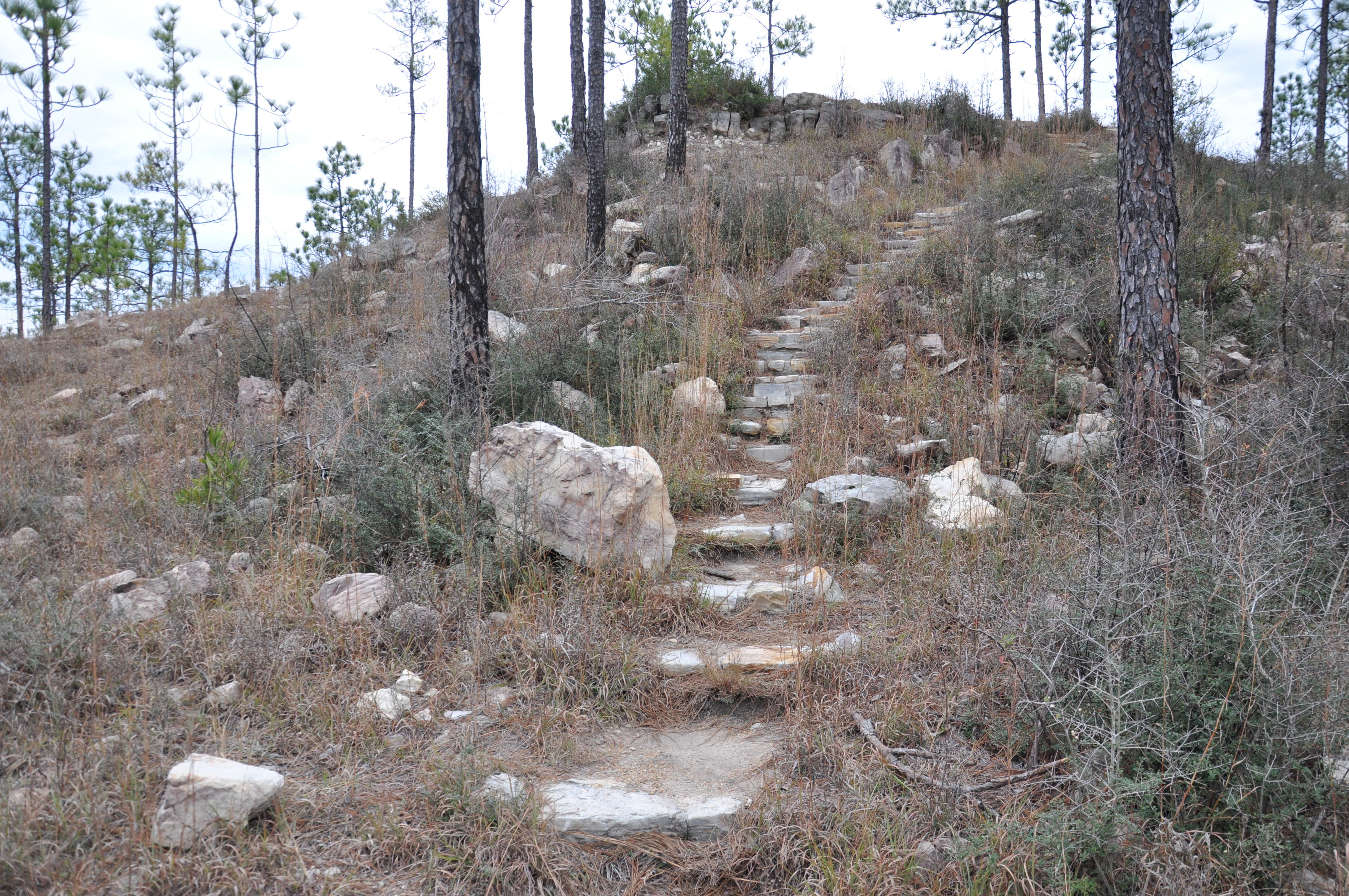 Any road trip north to Natchitoches should include a stop by Kisatchie National Forest. Divided into five districts, the forest offers an array of recreational opportunities – from hiking or biking to horseback riding or fishing. Choose from numerous trails, such as the 27-mile Wild Azalea Trail in the Calcasieu District–the longest trail in Louisiana. A perfect option for kids, though, is to drive the 17-mile Longleaf Scenic Byway and stop at the Longleaf Vista Interpretive Trail. A short stroll through bottomland hardwoods to a sandstone outcropping, the walk offers a seldom seen view of Louisiana’s “hill country.”
Any road trip north to Natchitoches should include a stop by Kisatchie National Forest. Divided into five districts, the forest offers an array of recreational opportunities – from hiking or biking to horseback riding or fishing. Choose from numerous trails, such as the 27-mile Wild Azalea Trail in the Calcasieu District–the longest trail in Louisiana. A perfect option for kids, though, is to drive the 17-mile Longleaf Scenic Byway and stop at the Longleaf Vista Interpretive Trail. A short stroll through bottomland hardwoods to a sandstone outcropping, the walk offers a seldom seen view of Louisiana’s “hill country.”
Clark Creek
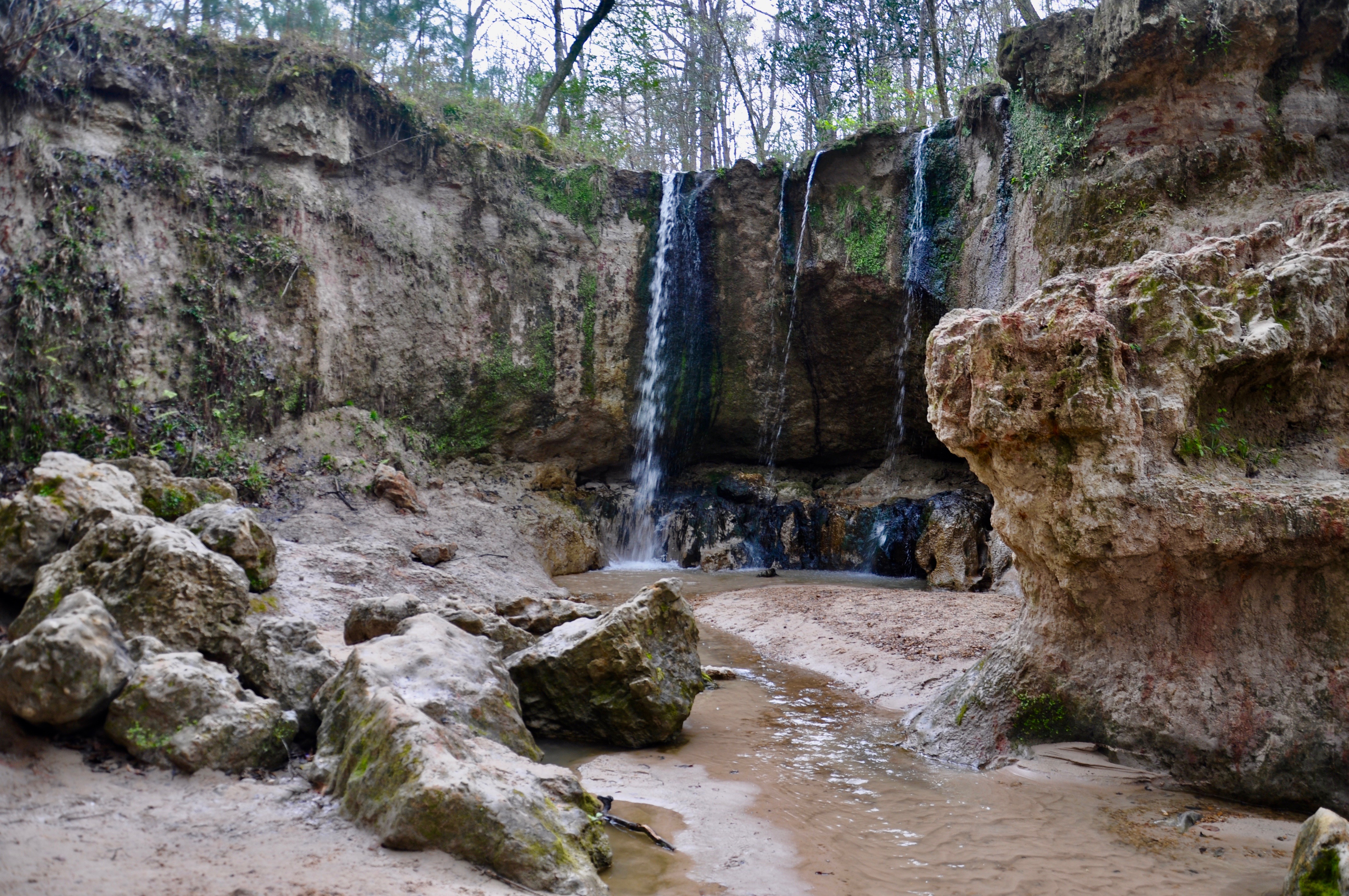 Technically in Mississippi, Clark Creek Natural Area is just across the border from St. Francisville. The trail begins along an excellent fossil hunting area and makes it way down to Clark Creek. Steep bluffs form the backdrop for the area’s waterfalls – a rare site in this part of the country. Spend the day here splashing through the creek and eating a picnic lunch by the waterfall. Be sure to carve out some time for a walk through picturesque St. Francisville on your way out.
Technically in Mississippi, Clark Creek Natural Area is just across the border from St. Francisville. The trail begins along an excellent fossil hunting area and makes it way down to Clark Creek. Steep bluffs form the backdrop for the area’s waterfalls – a rare site in this part of the country. Spend the day here splashing through the creek and eating a picnic lunch by the waterfall. Be sure to carve out some time for a walk through picturesque St. Francisville on your way out.
Big Branch Marsh National Wildlife Refuge
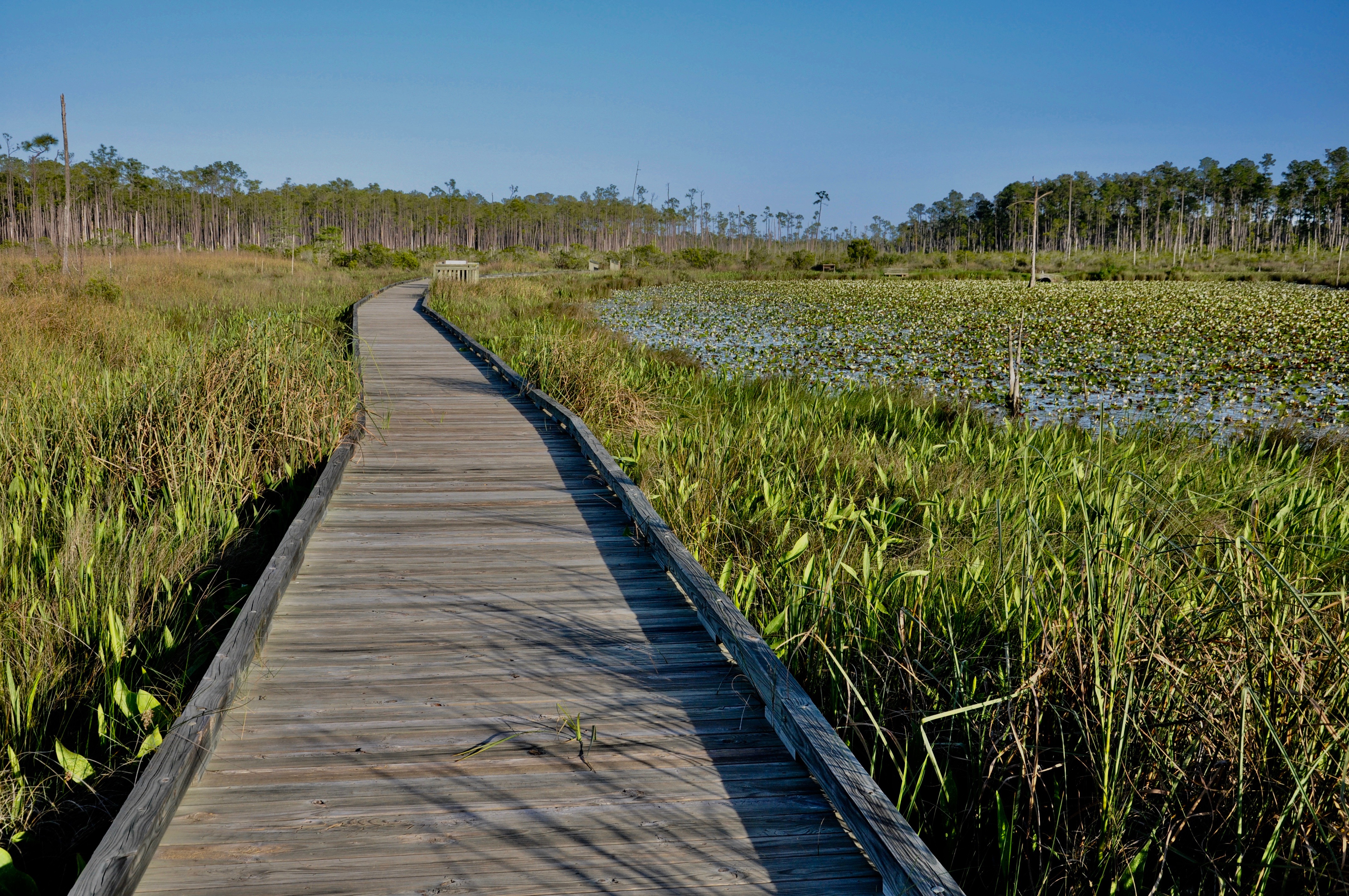
The Boy Scout Road trail at Big Branch Marsh National Wildlife Refuge takes you off the beaten path along Lake Pontchartrain’s northshore. Begin in a pine savannah leading to a half-mile interpretive trail along a boardwalk over a fresh mash. The trail then turns down a 2-mile, one-way gravel road known as Boy Scout Road. Walk through a forest to the edge of Bayou Lacombe. Years ago, schooners would sail here to carry locally made bricks across the lake to New Orleans. Don’t miss the Bayou Lacombe Visitor Center in Lacombe, featuring wildlife exhibits and trails through camellia, azalea and butterfly gardens.
Louisiana State Arboretum
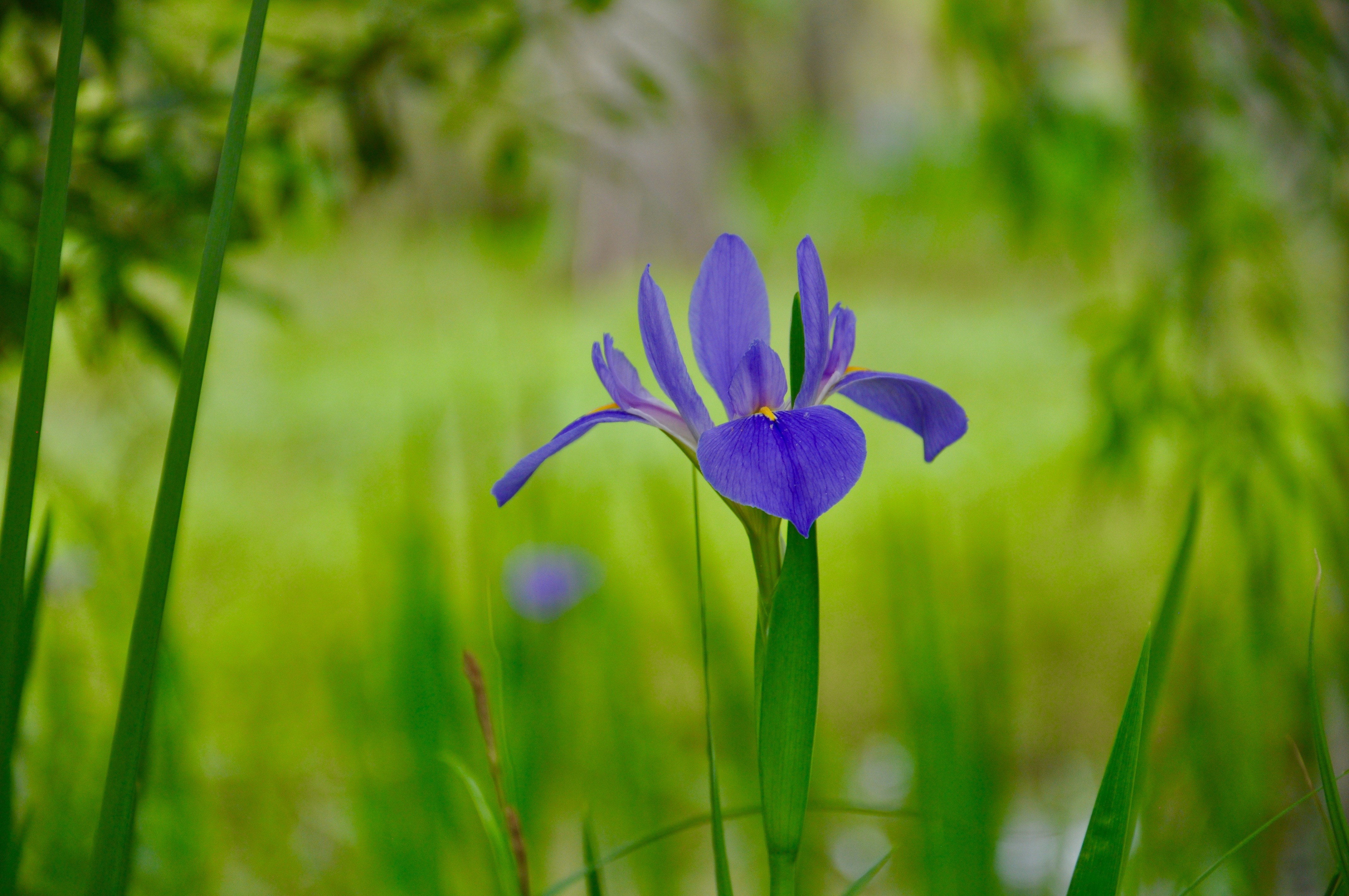
The 600-acre Arboretum came to fruition because of Louisiana naturalist Caroline Dormon. Located within Chicot State Park, the Arboretum features 6 miles of trails. The Walker Branch begins near Lake Chicot at the Nature Center. It ends near the Dormon Lodge, which has an exhibit to the noted naturalist. Several spur trails break off from the Walker Branch, leading to countless interpretive signs designating various species of trees. For the more adventurous, check out the 20-mile hiking trail around Lake Chicot.
This is actually just a tip of the list. Other hikes and walks we’ve discovered on our travels include the following:
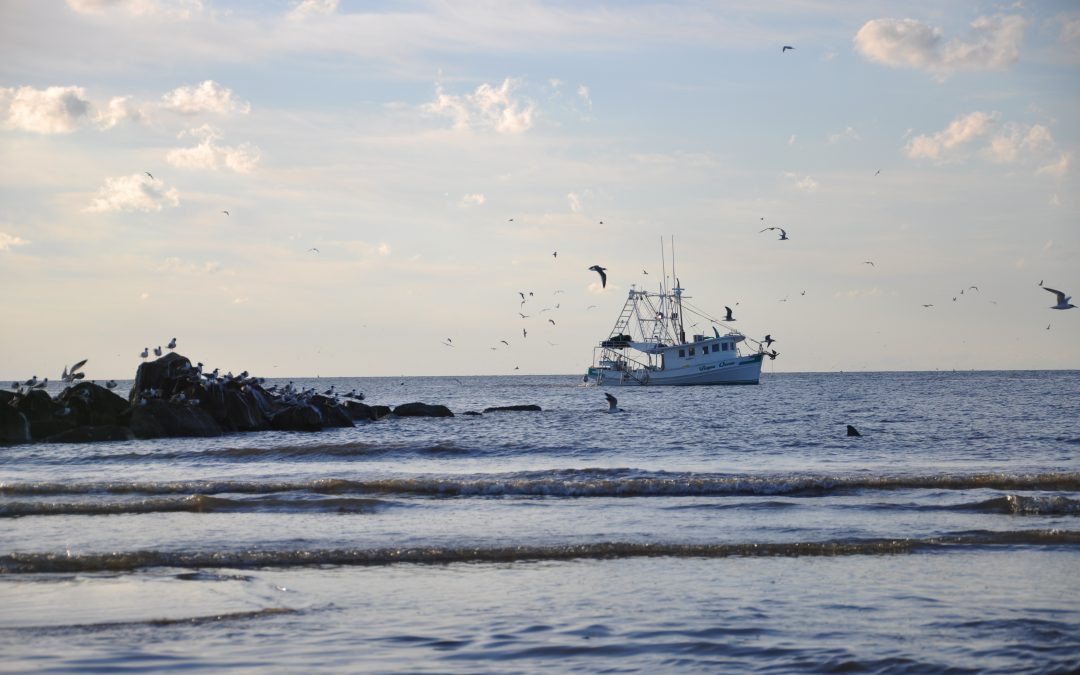
by admin | Aug 30, 2019 | Uncategorized
Make the most of the weekend by exploring new places on one of our Louisiana road trips. From historic towns to breathtaking scenery, new discoveries are all within a few hours drive of any corner of Louisiana.
St. Francisville

Arguably the most picturesque small town in the state, filled with historic plantations, stories of ghosts and the drawings of John James Audubon. Visit beautiful gardens and a walkable historic district. Outdoors enthusiasts love Tunica Hills’ waterfalls. And don’t miss Cat Island, home to the largest bald cypress tree in the world.
Cajun Country
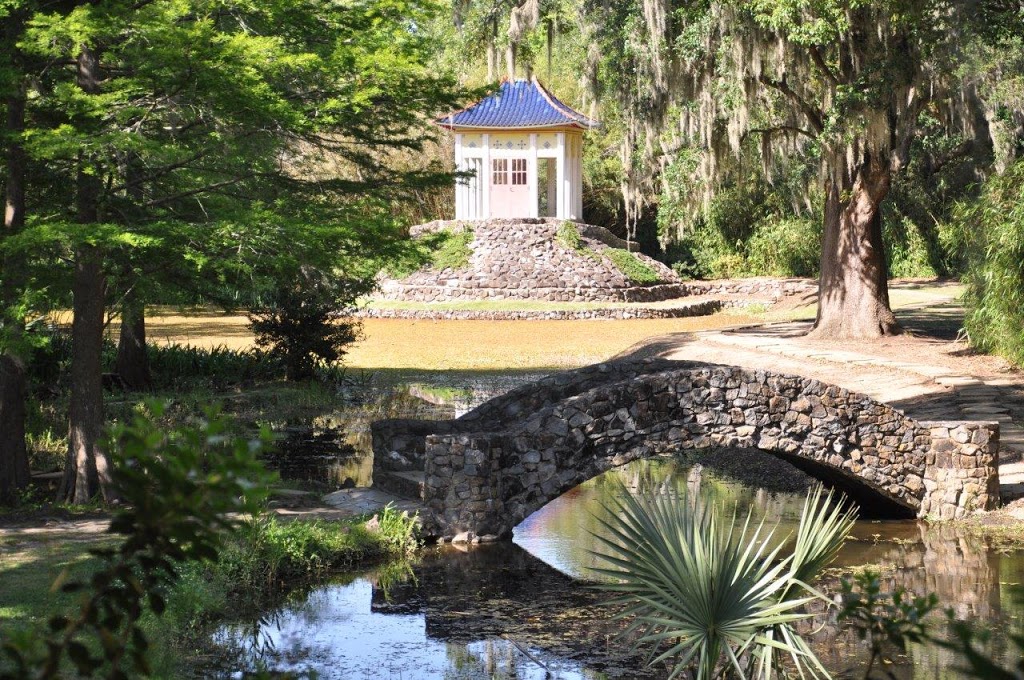
From Lafayette south, Cajun country is a land of boudin and Cajun dance halls, Tabasco and Rip Van Wrinkle Gardens. Paddle the other-worldly Atchafalaya Basin and meandering, scenic bayous. It’s a place where French is woven into everyday language, good food is a way of life and music festivals dominate the weekends.
Grand Isle
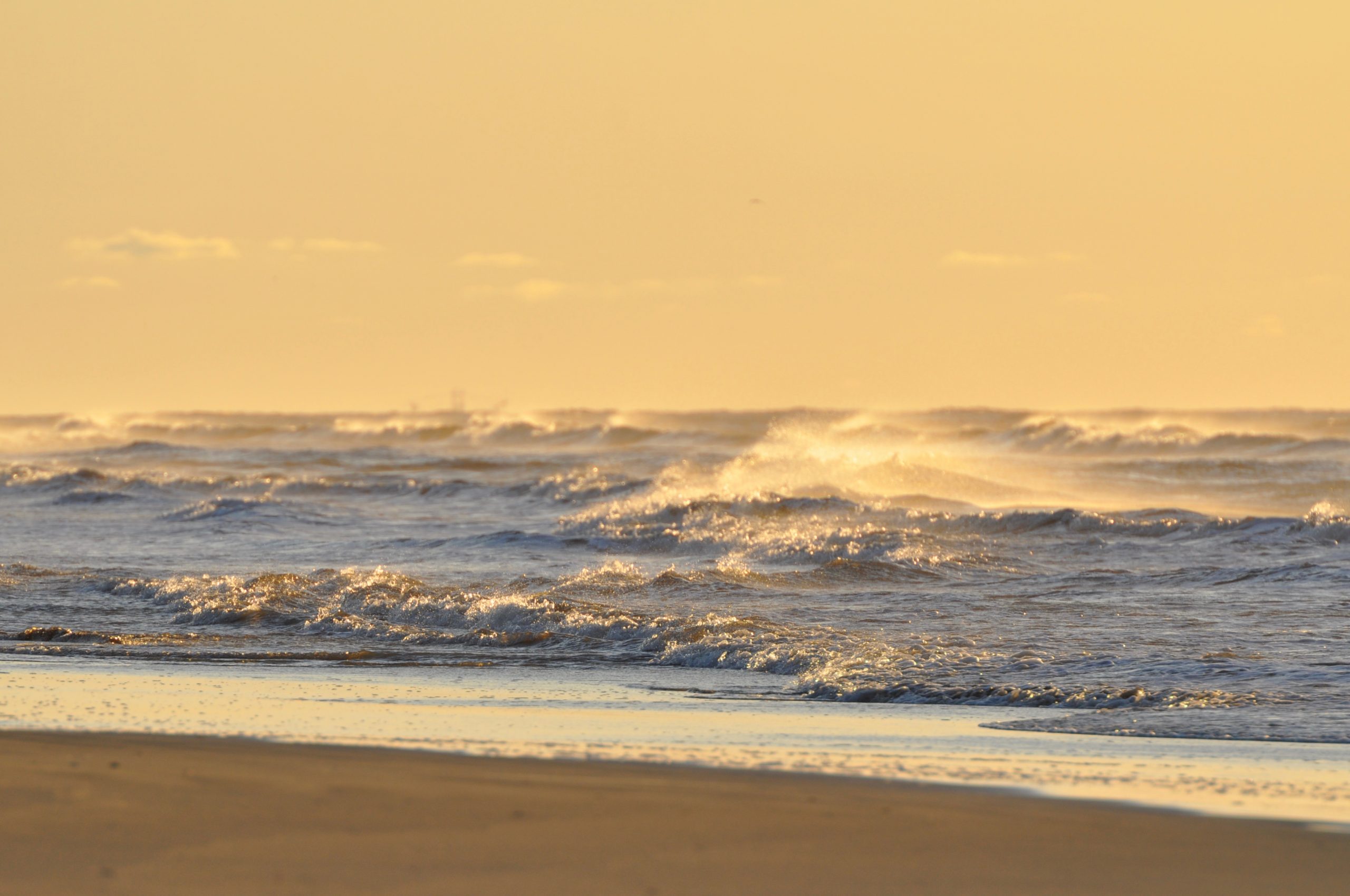
Wind your way down Bayou Lafourche (past the shrimp boats moored until next daylight) until the marsh opens up to the Gulf of Mexico. After all, getting to Grand Isle is half the experience. A fishing village on stilts, Grand Isle’s southern border boasts miles of sandy beaches and expansive Gulf views. Visit during peak migration and be greeted by thousands of song birds flocking to the inland forest. Camp on the beach at Grand Isle State Park. Take a boat ride to Queen Bess Island and view the pelican rookery. Or hire a charter and experience some of the best fishing in the world.
Natchitoches
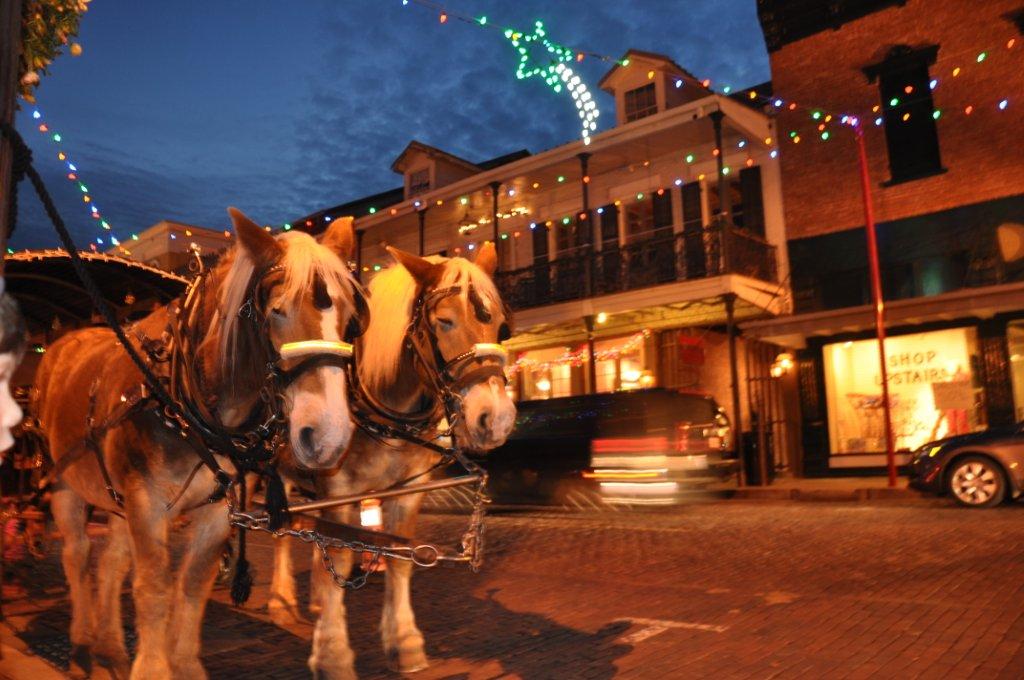
The oldest permanent settlement in Louisiana effortlessly blends historic with modern. The town offers a little something for everyone—from Fort St. Jean Baptiste and French Creole townhouses to world famous meat pies and the Louisiana Sports Hall of Fame. Don’t miss the Roque House and Gardens, the Cane River Creole National Historical Park, or Kisatchie National Forest.
New Orleans

Outsiders think the Crescent City is all Bourbon Street and nonstop partying. Yet locals know this most European of American cities is a gem for families. Start with the Audubon attractions (the Zoo and Aquarium are some of the best in the country and the Insectarium is a rare find for your bug-loving adventurer). Ride the streetcar, hopping off to visit Audubon Park. You might even catch the Roman Candy man with his mule-drawn cart.
Eat your fill of beignets while watching street performers in the Quarter. Then ride the Paddlewheeler to the Chalmette Battlefield. Bring a picnic to the Fly and watch the ships go by on the Mississippi. Or spend a day at City Park visiting the New Orleans Museum of Art, the Sculpture Garden, Amusement Park and Storyland, and the new Louisiana Children’s Museum. You can even paddle your own boat or surrey around the bayous and trails. And be sure to try every snoball stand you pass!
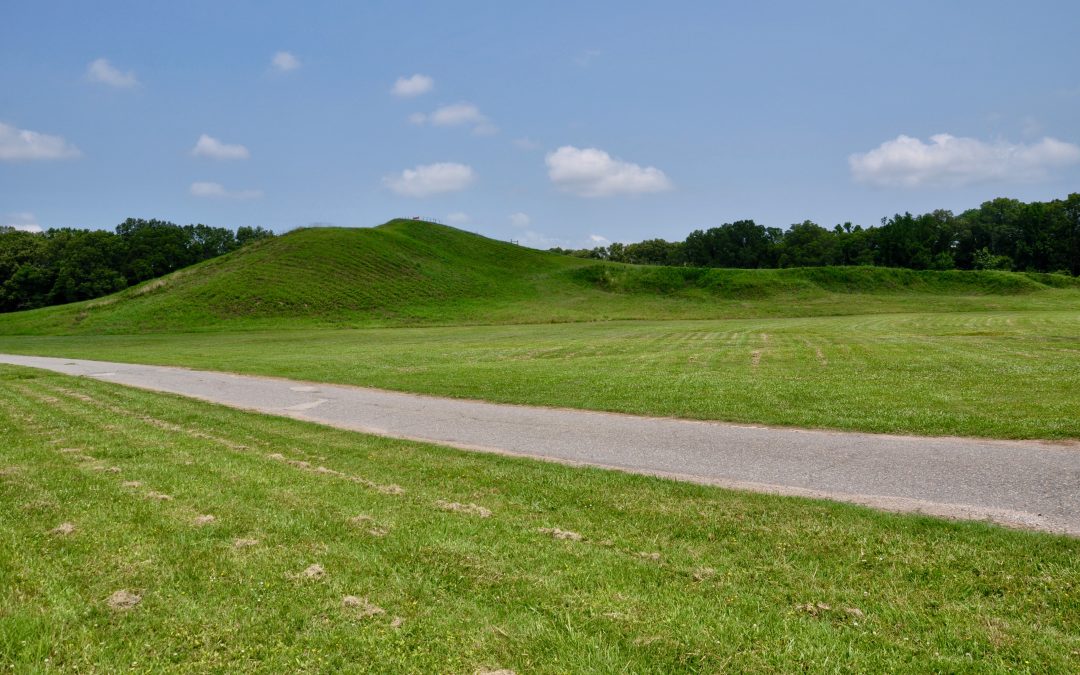
by admin | Aug 15, 2019 | Featured Posts, North Louisiana
Since our days at LSU, we have always been fascinated by mounds. It may have been climbing the mounds on LSU’s campus that got us started, and we haven’t stopped! Poverty Point is the king of mounds, so important that this State Historic Site is also a National Monument and a UNESCO World Heritage Site. Located in the northeast corner of the state, the site is unique for the size and shape of its earthworks, but it’s not alone. Many mounds dot the landscape throughout this area. You can follow their trail on the Indian Mounds of Northeast Louisiana driving tour.
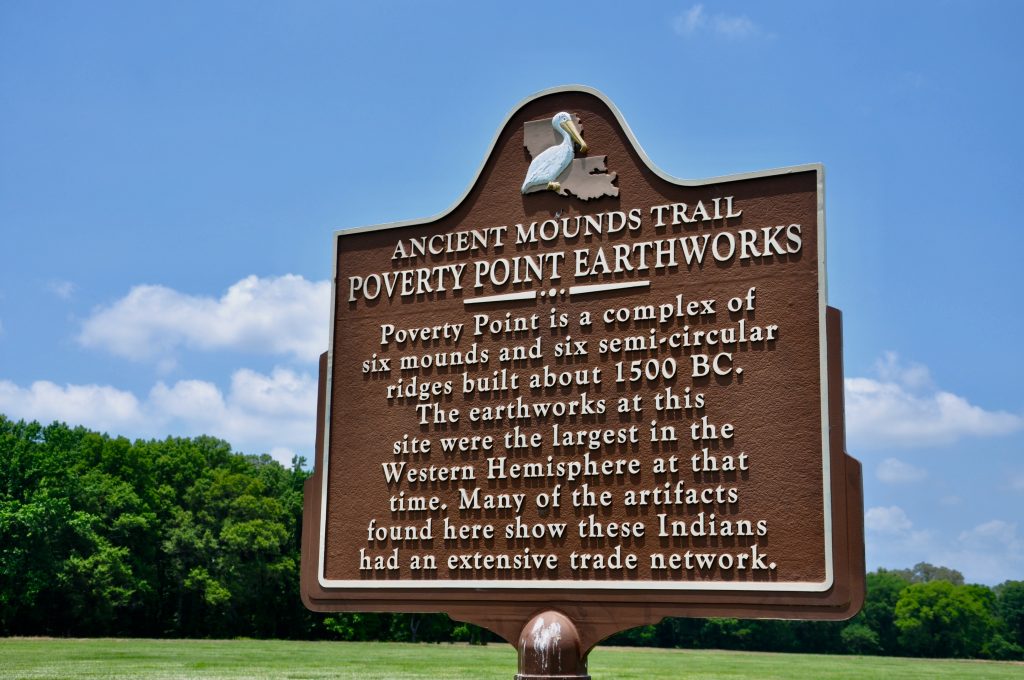
Poverty Point Culture
We began our tour at the visitor center, where we picked up Junior Ranger booklets for the kids. It’s a great way to encourage them to look around. While answering questions, they learned about the importance of the people who lived here and built these earthworks. The Poverty Point site is dated between 1700 and 1100 B.C. The inhabitants were pre-agricultural, relying on fishing, hunting and gathering for food. They had a complex trading system, using soapstone from Georgia and Alabama to make bowls and stone from the Ouachita and Ozark mountains for tools.
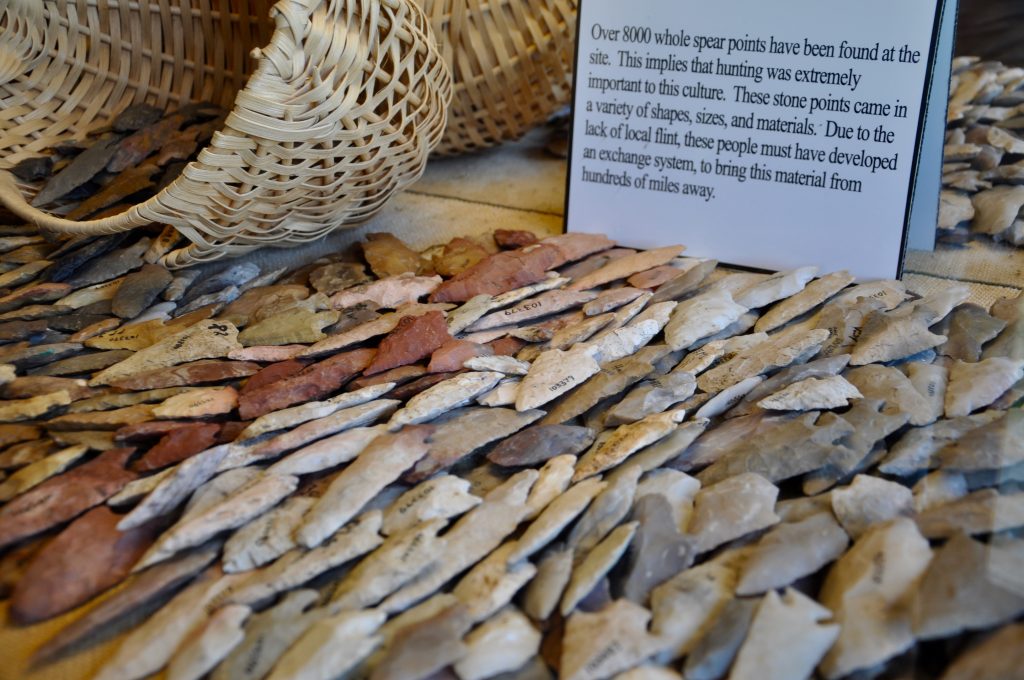
An impressive display of spear points is just a small amount of the more than 8,000 found at Poverty Point. But the most commonly found items are small clay balls. Known as Poverty Point Objects (PPOs), they were heated and then used for cooking food.
Earthworks and Mounds
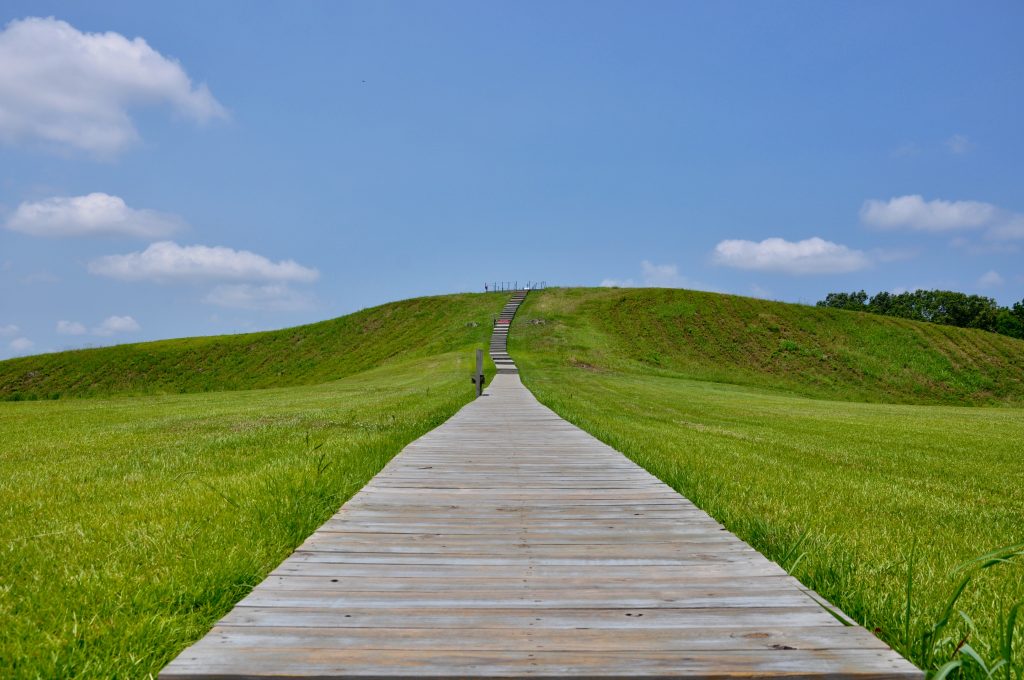
Back outside, we consulted our map and drove across Highway 577 to begin our tour. The loop trail passes right through the main earthworks–six rows of half-circles, which measure 3/4 of a mile in diameter and are each 4 to 6 feet tall. Archaeologists have found postmolds on top of these ridges, stains in the soil that are evidence of the remains of houses. Beyond the earthworks is one of the largest mounds in North America–Mound A. Sometimes called the bird mound, it’s 72 feet tall and 710 feet long and 660 feet wide. It may have taken 15.5 million basket loads of earth to build. It was quite a hike on a hot day just to go up and down those steps. I can’t imagine carrying dirt back and forth to build it!
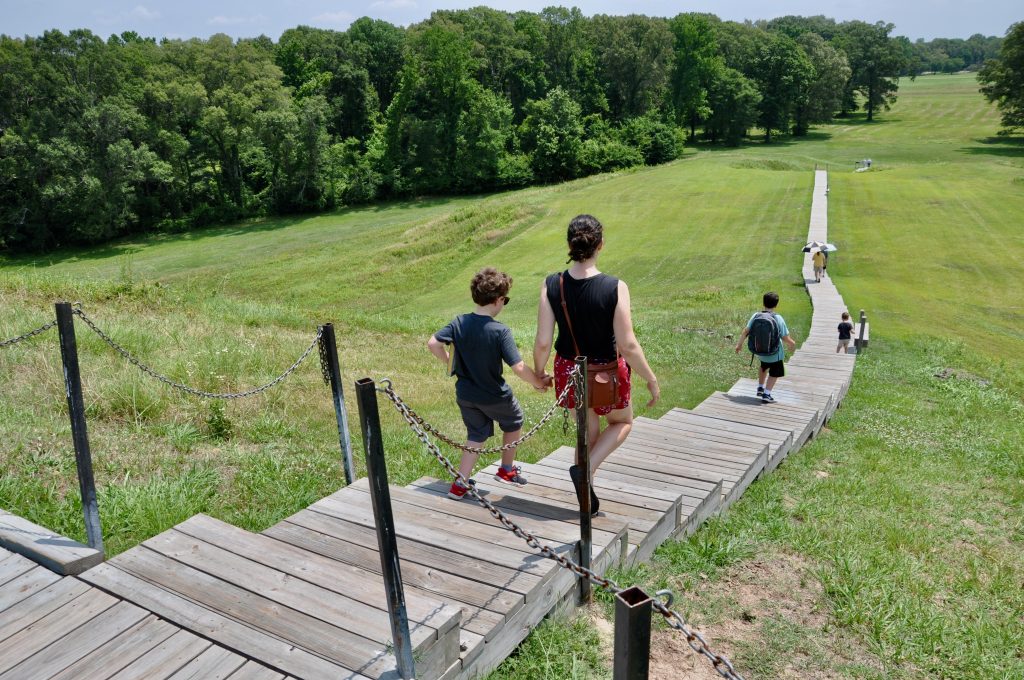
What makes Poverty Point so unique is the site’s enormous size as a major cultural center. This was the late Archaic period, when most everyone was living in small groups. But here, at Poverty Point, it’s estimated that hundreds of people lived together. In addition to Mound A and the earthworks, there are four smaller mounds on the property as well. The short driving tour brings you past them and back to the Visitor’s Center.
Hands-On Learning
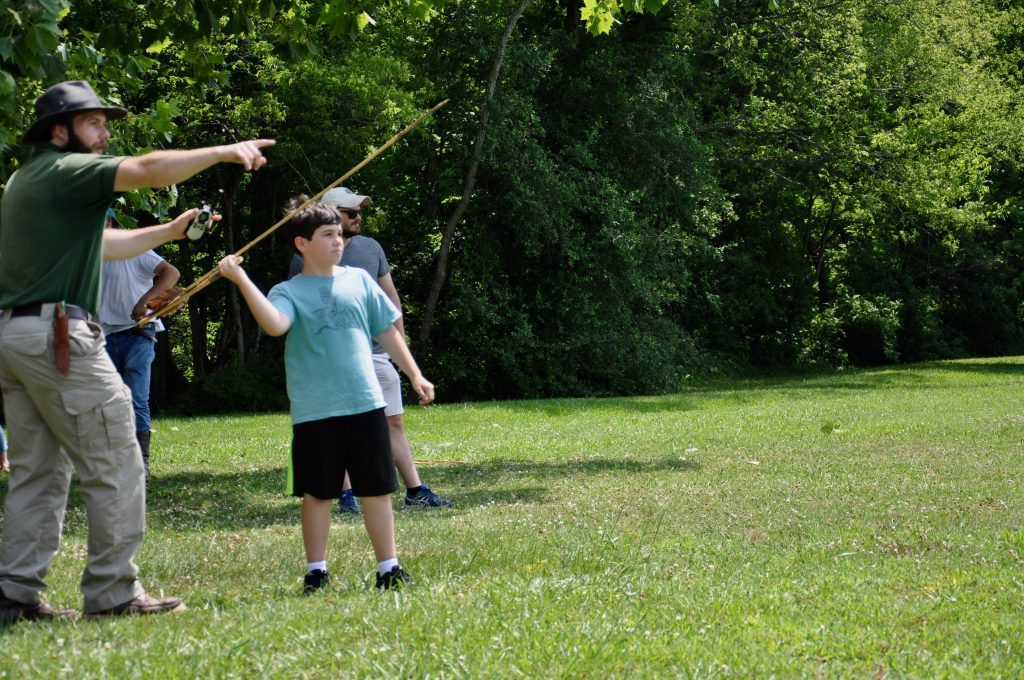
We were lucky to catch an atlatl demonstration when we returned. It’s basically a stick with a hook on the end to attach a spear. Once you get the hang of it, it launches a spear much farther than you can throw one. The boys took turns practicing and our oldest actually won the contest for his age group, bringing home his very own spear point. Marking off the last of their Junior Ranger books, the two older boys were sworn in as Junior Rangers, adding another badge to their growing collection.
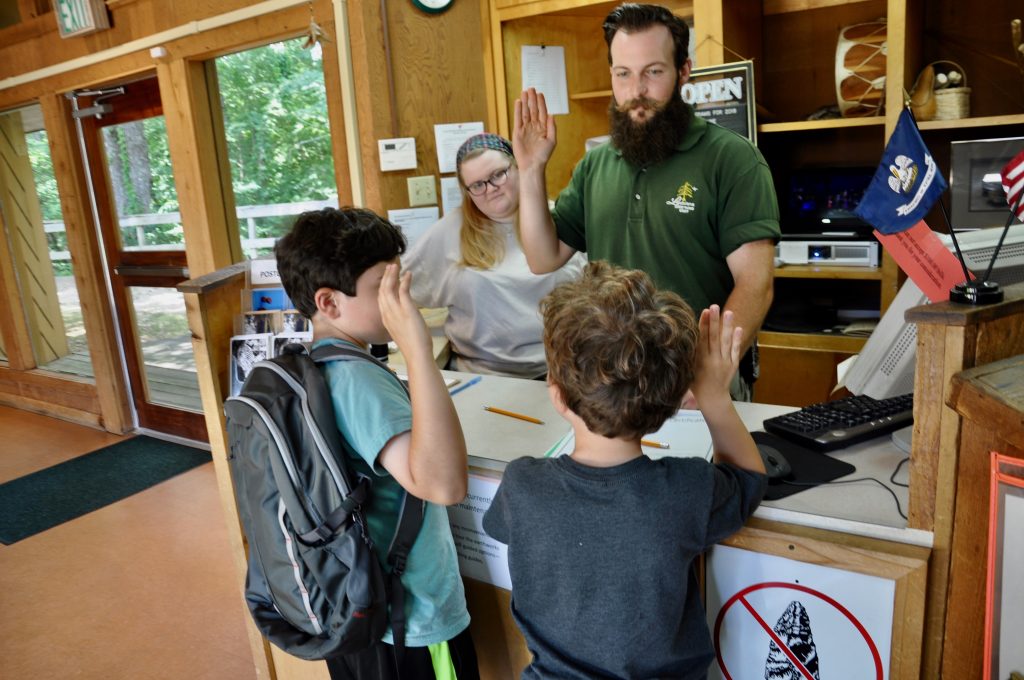
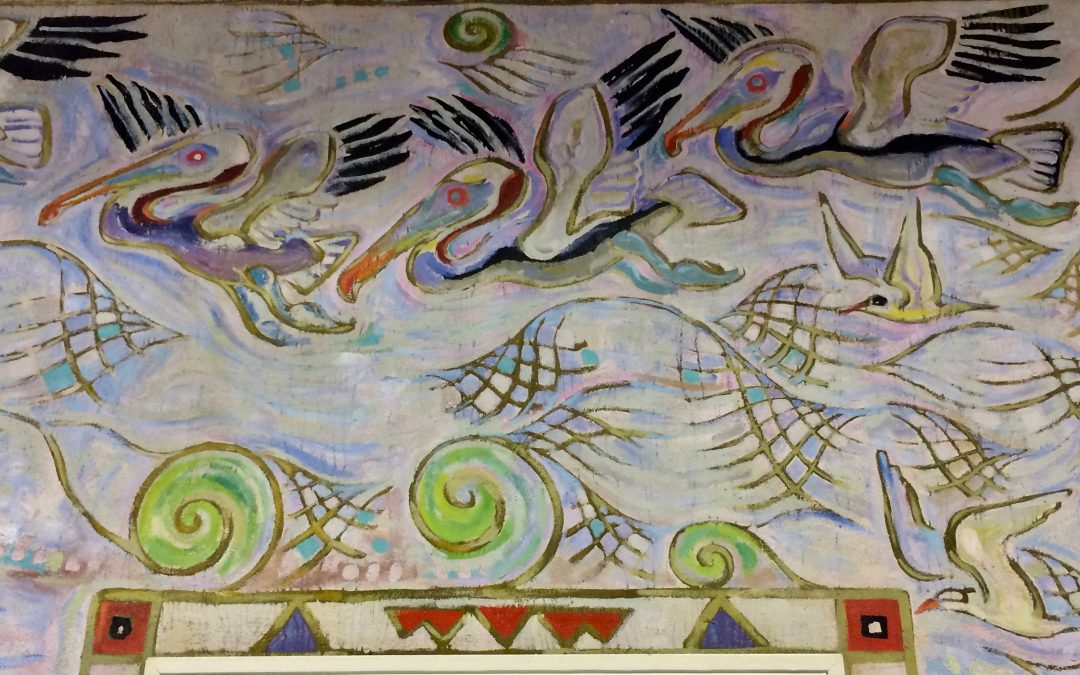
by admin | Jul 1, 2019 | Beyond the State, Mississippi
A short day trip from New Orleans, Ocean Springs is one of those small towns for which America is famous. Its historic downtown has quaint shops and restaurants lined up along a walkable main street, jutting off perpendicularly from a railroad line that runs straight through town.
Train Depot Housing “Realizations”
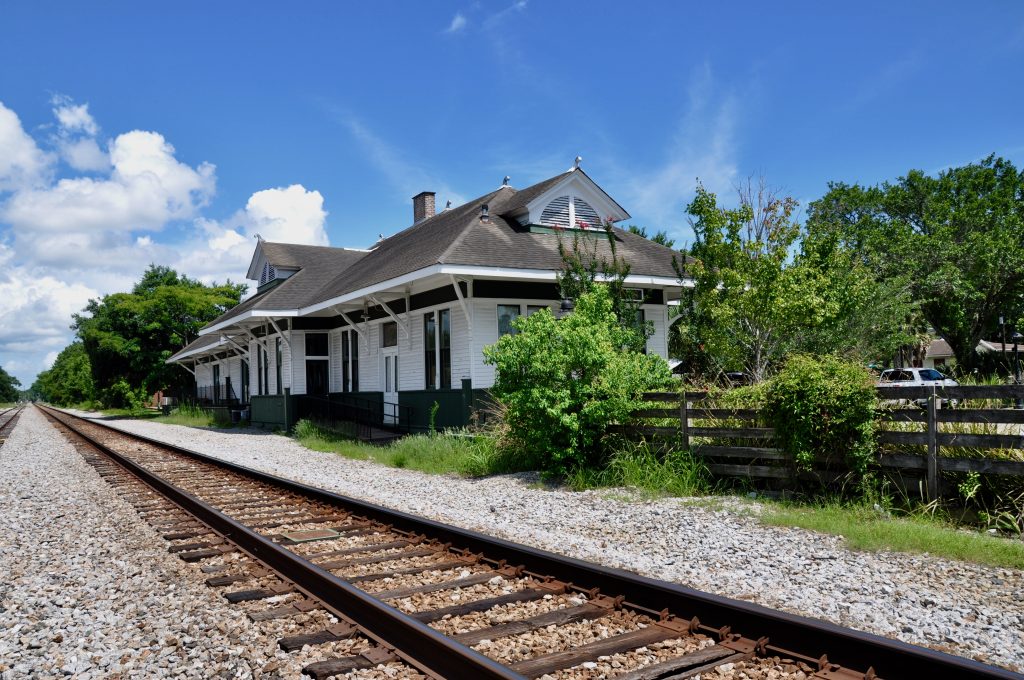
We went to Ocean Springs to learn about its most famous resident—Walter Anderson. A schizophrenic turned recluse, Anderson was a brilliant artist in the mid-1900s known for his colorful and quite fanciful paintings. Our first taste of his artwork was inside the old train depot next door to the Visitor’s Center. Run by Anderson’s family, “Realizations” has turned his kid-friendly designs into t-shirts, purses, bookmarks, posters and more. After buying some new tees for our boys, we scooted outside to the Saturday Fresh Market taking place in the depot’s parking lot (every Saturday 9 a.m. – 1 p.m.). Here, we sampled homemade goodies and browsed the produce and plants for sale before continuing down Washington Avenue.
Walter Anderson Museum of Art
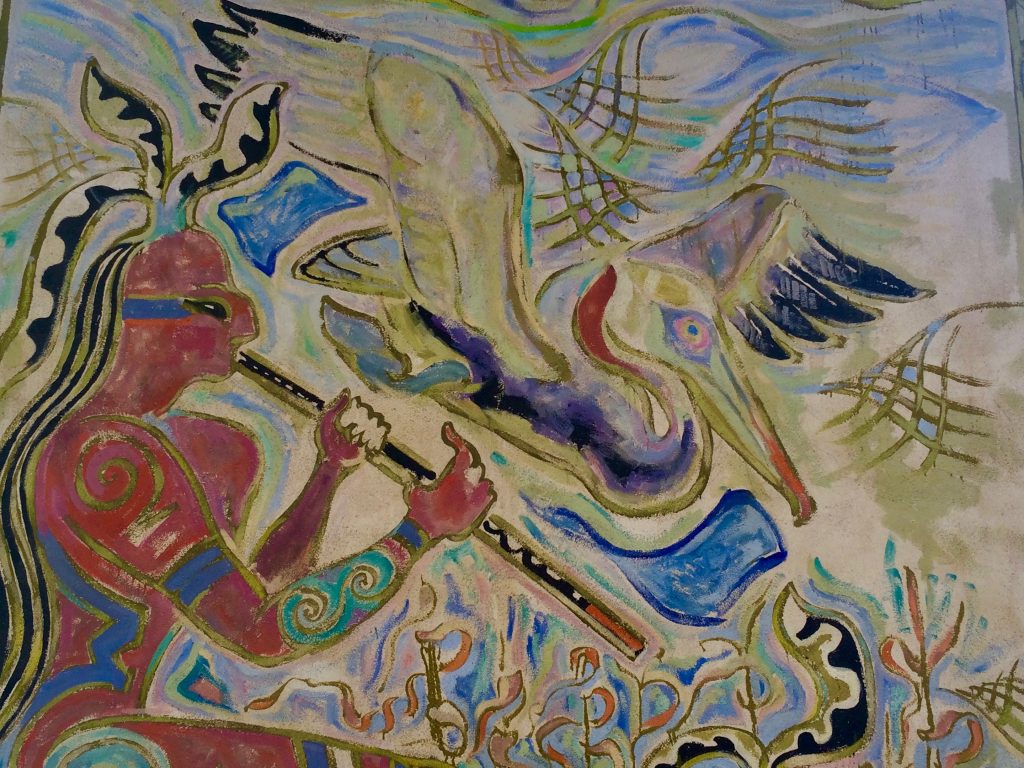
Dedicated to Walter Anderson’s artwork, the Walter Anderson Museum of Art houses more than 1,000 pieces of art. These include elaborate murals depicting his life and discoveries on the Gulf Coast. We stood for an eternity gazing at the Community Center murals, pointing out the animals and scenes hidden within it. Then we marveled at how he created the “Little Room” murals without a sole seeing them until after his death.
Marina and Shearwater Pottery Showroom
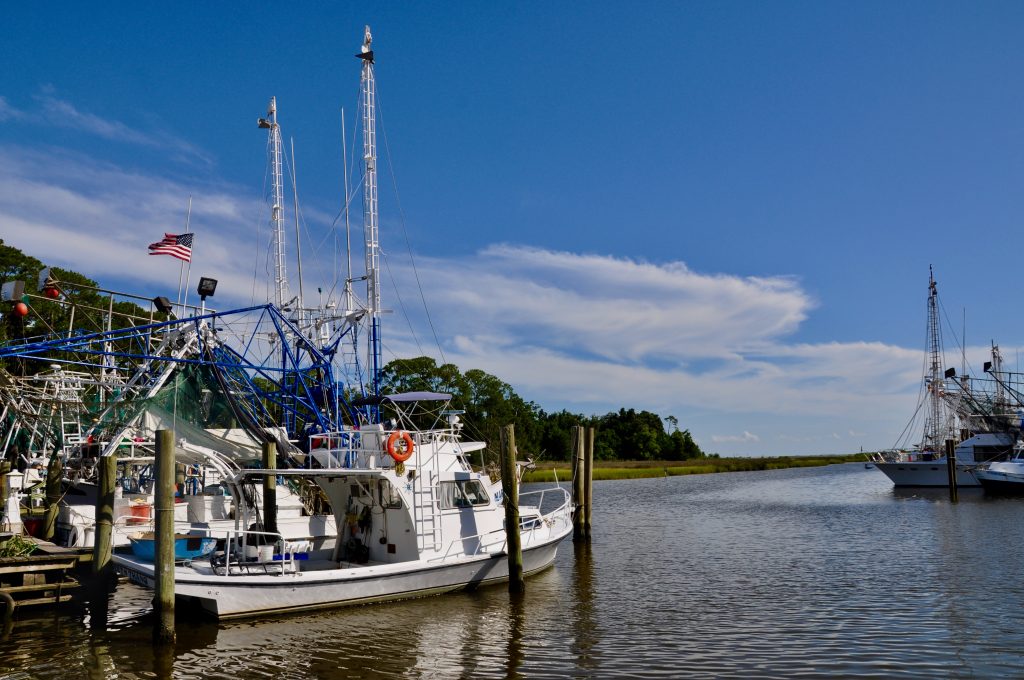
Our next stop took us to the family business. Shearwater Pottery was started by Walter’s brother Peter and is today owned by Peter’s four children. Three of them carry on the tradition of crafting decorative, functional clay pieces. The workshop, annex and showroom are tucked away in the woods close to the water’s edge. The drive to visit the shop is almost as scenic as the pottery itself, as you pass a boat-filled marina on an inlet off the Gulf.
Gulf Islands National Seashore Trail
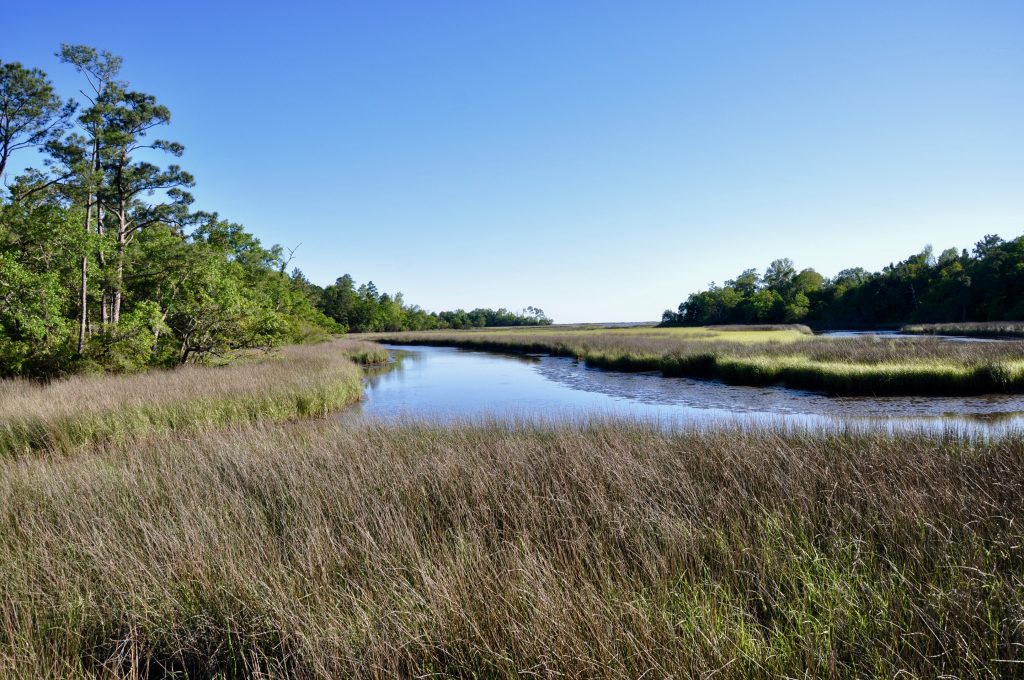
By this point, the kids were starting to get antsy and needed some quality “hyper” time. So we headed off to Gulf Islands National Seashore to hike the scenic, coastal forest trail. They zoomed across the pathways, stopping briefly to search for fish and turtles in the still waters beneath the fishing pier. Then they looped back around to the Visitor’s Center where exhibits detailed the area’s beauty and mystique.
Fort Maurepas City Park & Nature Preserve
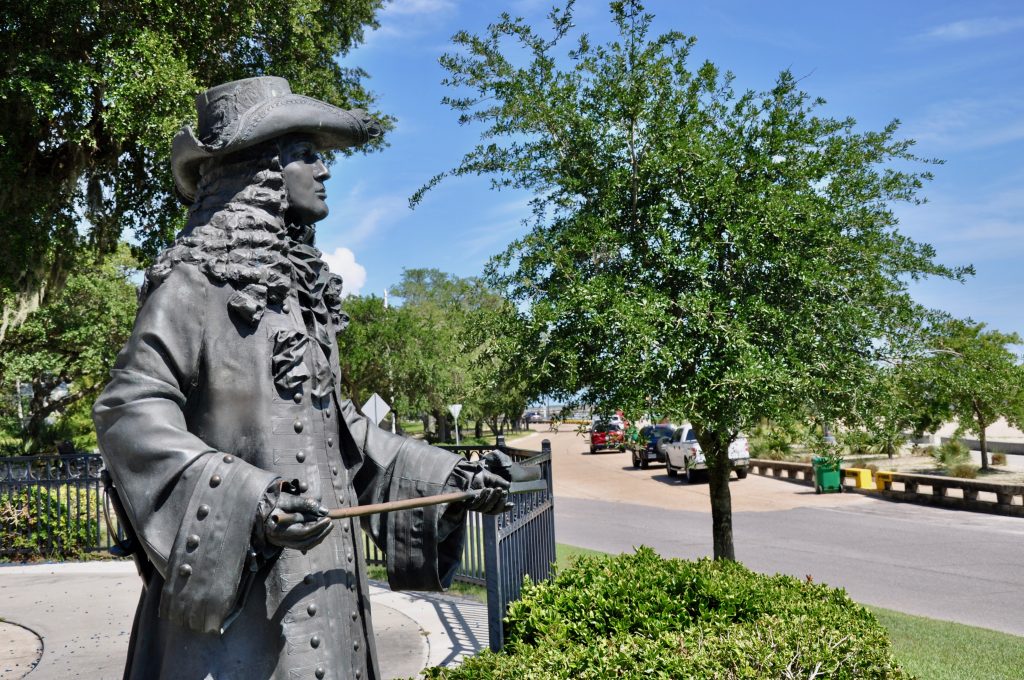 A great place to spend a hot summer afternoon, Fort Maurepas Park on Front Beach Drive overlooks the Gulf. It also features a splash pad and a ship playground. If you bring along a fishing pole, a fishing pier juts out into the Gulf from here as well. Throwing on their bathing suits, the kids cooled off while we sat in the shade and watched the boats go by. The playground rests near the former site of Fort Maurepas. The fort was built in 1699 by French explorer Pierre Le Moyne d’Iberville (pictured here). Fort Maurepas was the site of the first European colonization in Mississippi. In 1719, it briefly served as the capital of Louisiana.
A great place to spend a hot summer afternoon, Fort Maurepas Park on Front Beach Drive overlooks the Gulf. It also features a splash pad and a ship playground. If you bring along a fishing pole, a fishing pier juts out into the Gulf from here as well. Throwing on their bathing suits, the kids cooled off while we sat in the shade and watched the boats go by. The playground rests near the former site of Fort Maurepas. The fort was built in 1699 by French explorer Pierre Le Moyne d’Iberville (pictured here). Fort Maurepas was the site of the first European colonization in Mississippi. In 1719, it briefly served as the capital of Louisiana.
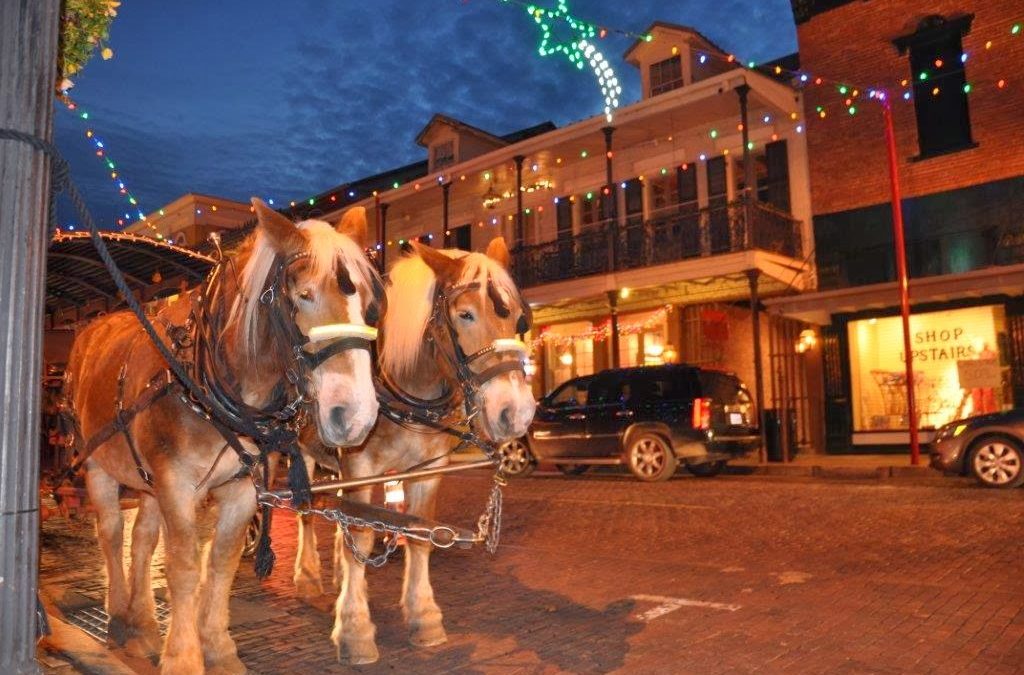
by admin | Dec 4, 2013 | Cajun Country, Greater New Orleans, North Louisiana, River Road
With Thanksgiving behind us and the tree ready for decorating in our front room, I can officially say we’re full swing into the holiday spirit. This is the time of year I make my wish list of must-hit events and prepare the kids for running full steam ahead until Christmas.
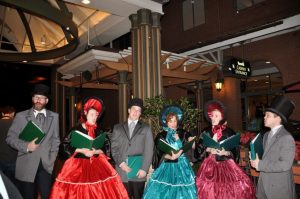 |
| Caroling at Miracle on Fulton Street |
We start with the tried and true ones, from Celebration in the Oaks at City Park to Santa, real reindeer and fake “snow” at the Miracle on Fulton Street. Then there’s the winter wonderland created in the lobby of the Roosevelt Hotel and the evening out sans children for a special Reveillon dinner.
We also try to mix in a few new experiences to brighten the holidays. Last year, we tried a children’s rendition of the Nutcracker at Loyola University and a staging of A Christmas Carol at the Contemporary Arts Center. For New Year’s, we ventured north to Natchitoches to experience the Christmas Festival of Lights, well worth the trip for anyone thinking of visiting this beautiful, historic town.
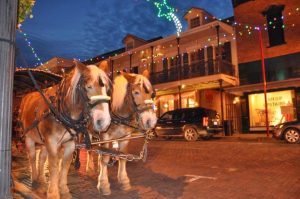 |
| Natchitoches’ Christmas Festival of Lights |
This year, I’ve been eyeing the Moscow Ballet’s Great Russian Nutcracker at the New Orleans Saenger. Perhaps we’ll set off out of town again to experience what the rest of the state has to offer. This weekend, the small town of Arnaudville pulls together some of the region’s best artists for Fire and Water: Le Feu et l’Eau Rural Arts Celebration.
It’s also the time for holiday bonfires, which, believe it or not, we have never seen! Oak Alley hosts their 38th Annual Christmas Bonfire Party this Saturday, Dec. 7. The 24th Annual Festival of the Bonfires lights up next weekend in Lutcher, offering a glimpse into the much-anticipated Christmas Eve bonfire spectacular in Gramercy and Lutcher.
With so much going on, it’s hard to decide where to even begin. Perhaps start with my article in Country Roads on ways for “Lighting the Dark” this holiday season or check out their Calendar of Events for endless possibilities. Maybe we’ll see you around town as you discover the joy of winter in Louisiana.
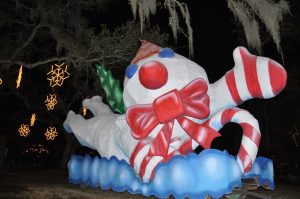 |
| Mr. Bingle at Celebration in the Oaks |

